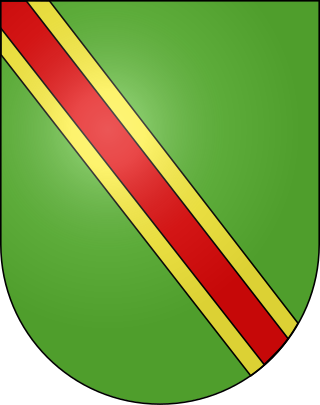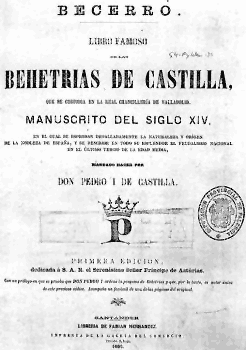
Cantabria is an autonomous community and province in northern Spain with Santander as its capital city. It is called a comunidad histórica, a historic community, in its current Statute of Autonomy. It is bordered on the east by the Basque autonomous community, on the south by Castile and León, on the west by the Principality of Asturias, and on the north by the Cantabrian Sea, which forms part of the Bay of Biscay.

Íñigo López de Mendoza, 1st Marquess of Santillana was a Castilian politician and poet who held an important position in society and literature during the reign of John II of Castile.

Torrelavega is a municipality and important industrial and commercial hub in the single province Autonomous Community of Cantabria, northern Spain.

Liébana is a comarca of Cantabria (Spain). It covers 575 square kilometres and is located in the far southwest of Cantabria, bordering Asturias, León and Palencia. It is made up of the municipalities of: Cabezón de Liébana, Camaleño, Cillorigo de Liébana, Pesaguero, Potes, Tresviso and Vega de Liébana.

The Mendoza family was a powerful line of Spanish nobles. Members of the family wielded considerable power, especially from the 14th to the 17th centuries in Castile. The family originated from the village of Mendoza in the province of Álava in the Basque countries

Íñigo Lopez de Mendoza y Pimentel, 4th Duke of the Infantado was a Spanish nobleman. He was made a Knight of the Order of the Golden Fleece in 1546, the 193rd to receive that distinction. Duke of the Infantado is a title first granted in 1475 and was inherited upon his father's death in 1531. He was also 5th Count of Saldaña, 4th Marquess of Argüeso, 4th Marquess of Campóo, 5th Marquess of Santillana, 5th Count of Real de Manzanares, Señor de Mendoza, Señor de Hita, and Señor de Buitrago.

Diego Hurtado de Mendoza y Luna, 3rd Duke of the Infantado, nicknamed El Grande, was a Spanish noble.

Don Diego Hurtado de Mendoza y Figueroa, 1st Duke of the Infantado, or Diego Hurtado de Mendoza y Suarez de Figueroa was a Spanish noble.

Íñigo López de Mendoza was the second son of famous Spanish Poet and nobleman Íñigo López de Mendoza y Lasso de la Vega, marquis of Santillana, (1398–1458), and the cadet brother of Diego Hurtado de Mendoza, 1. duque of l'Infantado,, the brother also of Archbishop and Cardinal Pedro González de Mendoza,, named by his contemporaries "the third king of Spain".

Duke of the Infantado is a Spanish peerage title that was granted to Diego Hurtado de Mendoza y Figueroa, son of Íñigo López de Mendoza, 1st Marquis of Santillana, by the Catholic Monarchs, Ferdinand II of Aragon and Isabella I of Castile, on 22 July 1475.

Íñigo López de Mendoza y Luna was a Spanish noble, the second Duke of the Infantado and third Marquis of Santillana.

Íñigo López de Mendoza y Quiñones, was the first Marqués de Mondéjar, and second Conde de Tendilla. He was known as El Gran Tendilla, and was a Spanish noble of the House of Mendoza. He was the son of Íñigo López de Mendoza y Figueroa, the first Conde de Tendilla, and the grandson of the poet Íñigo López de Mendoza, 1st Marquis of Santillana.

Leonor Lasso de la Vega was a Spanish noble woman from Cantabria and head of the prestigious House of Lasso de la Vega from 1367 - 1432.

The House de la Vega, Laso de la Vega or Lasso de la Vega is a Spanish noble line from the Kingdom of Castile. The family origins lie in the areas now known as Torrelavega which was established in the Middle Ages. The House of de la Vega was one of the most important families in the territory, which now makes up Cantabria, and they dominated a large amount of the terrain and property between the Torre de la Vega and the Castillo de Argüeso.

María Francisca de Silva-Mendoza-Sandoval y Gutiérrez de los Ríos was a Spanish noblewoman of the House of Mendoza and the last Mendoza to hold title over the Dukedom of the Infantado. She was the 11th Duchess of the Infantado and also held the associated titles of Duchess of Lerma and of Pastrana.

Rodrigo Díaz de Vivar y Mendoza, was a Spanish noble of the House of Mendoza. He was the firstborn son of the powerful Cardinal Pedro González de Mendoza and went on to become the 1st Conde del Cid and the 1st Marquis of Cenete, a title he held from 1491 until his death.

Potes is a municipality in the autonomous community of Cantabria in Spain. It is the capital of the Comarca of Liébana and is located in the centre of it. It is bordered to the north by Cillorigo de Liébana, to the west by Camaleño, to the south by Vega de Liébana and to the east by Cabezón de Liébana.

Asturias de Santillana is a historical comarca whose territory in large part corresponded to the central and western part of today's autonomous community of Cantabria, as well as the extreme east of Asturias. Most of the province of Asturias belonged to the comarca of Asturias de Oviedo. Also known also as a merindad and documented since the 13th century, Asturias de Santillana comprised the western part of Cantabria including the Saja River valley and the Nansa River. Its borders used to go along the coast from the council of Ribadedeva to the municipality of El Astillero, to the shores of the Bay of Santander), which leads to the administrative division of Trasmiera. From the south it went up to the Cantabrian cordillera. All of the valleys of this comarca are perpendicular to the coast.

The Hermandad of the Cuatro Villas de la Costa de la Mar, also cited under the name Cuatro Villas de la Costa de Cantabria, was a medieval and modern administrative entity that grouped the coastal cities of the north of the kingdom of Castile, all of them part of present-day Cantabria; namely, from west to east: San Vicente de la Barquera, Santander, Laredo, and Castro-Urdiales. At the end of the 15th century, it became part of the corregimiento of the Cuatro Villas along with other territories in the north of the Iberian Peninsula. In 1514 the province was renamed the corregimiento de las Tres Villas de la Costa, by separation from the town of San Vicente, which rejoined in 1521. Towns twinned since the 13th century, its foundation as a corregimiento dates back to the reign of the Catholic Monarchs, around 1496, surviving until its inclusion in the province of Cantabria in 1778.

The Count of Castañeda, ruled by the Counts of Castañeda, a Spanish noble title of late medieval origin, was the first physical territory granted to an aristocrat in the region now occupied by the autonomous community of Cantabria. It initially belonged to the Manrique family. Geographically, it was located in territory originally belonging to the Asturias de Santillana comarca, bordering to the west with the marquisate of Santillana. The nobility title was used for centuries by the eldest sons of the holders of the marquisate of Aguilar de Campoo, first class Grandee of Spain, nowadays, both dignities are separated.


















